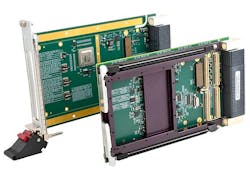VPX rugged embedded computing market set to exceed venerable VME by 2017, analyst says
That's the prediction of Toby Colquhoun, senior analyst for discrete and process automation at market researcher IHS Technology in Englewood, Colo. Colquhoun made his comments Monday at the Embedded Tech Trends conference in Phoenix.
VPX, based on the VITA 46 industry standard overseen by the VITA Open Standards and Open Markets industry trade group in Fountain Hills, Ariz., is an embedded computing circuit board and backplane standard for ruggedized and mobile computing that has been embraced primarily by the U.S. defense industry.
Military applications represent 80 percent of the VPX market, Colquhoun told Embedded Tech Trends attendees Monday morning. Other industries interested in VPX included industrial automation, transportation, and medical applications.
The recent downturn in U.S. defense spending has limited growth in VPX, Colquhoun says. While the U.S. defense budget reached a high-water market in 2010 amid military conflicts in Iraq and Afghanistan, the 2014 American defense budget was at a long-time low, which illustrates how quickly defense spending has fallen.
Related: VPX emerging as the industry choice for high-performance embedded computing
While 2015 defense spending is showing a slight increase over the previous year, Colquhoun predicts that the U.S. defense budget will remain flat through at least 2020, which could hold back VPX market growth.
Nevertheless, VPX embedded computing technology is on a upward market trend despite market headwinds, and should be a major factor in future aerospace and defense new systems and systems upgrades in cyber security, unmanned vehicles, special operations, and other applications where size, weight, and power consumption (SWaP) are major concerns.
VPX uses high-speed serial data interconnects like Gigabit Ethernet and InfiniBand to move data quickly among processor, I/O, and other circuit cards in electronic enclosures of various sizes. VPX replaces or augments older VME technology, which moves data among cards in an enclosure via older parallel databus technology.
As VPX technology gains market share, the older yet still viable VME will diminish in stature, Colquhoun predicts. VME embedded computing technology has dominated military applications since the 1990s, yet should shrink by 5 to 10 percent over the next five years, he says.
By 2017 sales of VPX embedded computing should exceed that of VME for the first time, Colquhoun says. After that sales of VME solutions for military applications are expected to tail off into a niche design approach primarily involved in system maintenance and upgrades.
Related: Navy chooses 6U VME single-board computers from GE for shipboard tactical training system
VPX was introduced in 2006, and began taking off in aerospace and defense applications with the OpenVPX working group, which in 2009 began developing system-level specifications for improving the interoperability of 3U and 6U VPX circuit cards.
As the VPX market has unfolded, the larger 6U VPX approach has been the choice for the most demanding embedded computing challenges for applications like radar, electronic warfare (EW), and signals intelligence (SIGINT) signal processing.
The smaller 3U VPX technology has become the choice of SWaP-constrained rugged mobile applications for applications like unmanned vehicles and mobile communications.
While 6U VPX has a reputation for handling the most complex computing, 3U VPX computing capability is improving steadily. Powerful Intel multicore Core i7 microprocessors have been implemented on 3U VPX, and some industry experts believe that server-class processors like the Intel Xeon could be implemented on 3U VPX within the next three years.
For more information contact the Embedded Tech Trends conference online at www.embeddedtechtrends.com, IHS Technology at www.ihs.com, or the VITA trade organization at www.vita.com.
